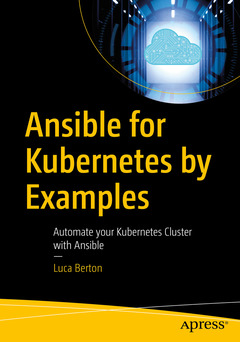Ansible for Kubernetes by Example, 1st ed. Automate Your Kubernetes Cluster with Ansible
Auteur : Berton Luca

Learn how to automate your Kubernetes infrastructure using Ansible. This book will enable you to automate more tasks and save time with this human-readable platform.
Containerized microservices deployed via Kubernetes allows you to save time, reduce human interaction and errors, and create applications that are more robust. You?ll learn how to automate the most redundant activities such as reports, services, the launch of a pod, adding permanent storage, configuring load balancing, and adding or modifying any Kubernetes parameter. You'll also gain an understanding of end-to-end use cases and how advanced cluster automation, such as Helm packages and node states, are evolving.
Each lesson utilizes a specific use-case for the modern Kubernetes cluster and focuses on a single module from the most crucial parameter, complete with code demonstrations. Each code example is battle-proven in real-life with console interaction and verification.- Automate Kubernetes cluster management, cloud services, pods, and storage with Ansible
- Configure your Ansible controller node
- Write and execute Ansible Playbook code that follows best practices
- Augment your productivity by applying Infrastructure as Code (IaC)
- Troubleshoot Ansible
Who This Book Is For
IT professionals who would like a jargon-free understanding of Ansible technology, Windows Systems Administrators, DevOps professionals, thought leaders, and infrastructure-as-code enthusiasts.
Chapter Goal: The tools to handle a modern enterprise IT Infrastructure that enables Infrastructure as Code following DevOps methodologies
Sub -Topics
Modern IT Infrastructure (DevOps & IaC)The move to containers
Ansible by Red Hat
Kubernetes and the CNCF
Kubernetes distributions - OpenShift by Red Hat, Rancher, EKS, AKS, GCP
Containers & Pod
Creating a ‘Hello’ app
Building Hello App
Running Hello in Docker
Deploying Hello in Kubernetes
Hello Operator
Chapter 2: Ansible Language Code
Chapter Goal: Description of the Ansible Platform and how to write and execute Ansible Playbook code that follows the best practicesAnsible Installation
Ansible Code Language
Chapter Goal: How to automate container management using Ansible (Docker and podman)
Sub - Topics
Ansible For ContainersInstall Docker in Linux and Windows
Install and Update flatpak in Linux
Install a snap in Linux
Deploy Web Server in a Container for Linux (Docker and Podman)
Chapter 4: Ansible For K8s Tasks
Chapter Goal: How to configure your Ansible controller node to interact with a k8s cluster
Sub - Topics:
Why Kubernetes & How it works.
Set up your laboratory (cluster of VMs, Kubespray, Raspberry Pis, OpenShift local)
Minikube to Create a Cluster
Create a cluster with KOPS - ( Cloud )
Configure Ansible For Kubernetes
Ansible troubleshooting - Kubernetes K8s 401 Unauthorized
Configure a Python Virtual Environment
Configure an Ansible Execution Environment
Report a list of namespaces
Report all deployments in namespace
Create Kubernetes K8s namespace
Create Kubernetes K8s pod
Create Kubernetes K8s secret
Using a Service to Expose Your App
Scale Your App
Update Your App
Assign CPU Resources to Kubernetes K8s Containers and Pods
Assign Memory Resources to Kubernetes K8s Containers and Pods
Configure a Pod to Use a Volume for Storage
Apply Multiple YAML Files at Once on Kubernetes K8s
Chapter 5: Ansible For K8s Use-Cases
Chapter Goal: Some end-to-end examples about Ansible for Kubernetes usage
Sub - Topics:
Configuring a Java MicroserviceStateless - Deploying PHP Guestbook application with Redis
Stateful Deploying WordPress and MySQL with Persistent Volumes
Apply Pod Security Standards at the Namespace Level
Restrict a Container's Access to Resources with AppArmor
Restrict a Container's Syscalls with seccomp
Chapter Goal: How to automate system administration tasks for your K8s cluster using Ansible automation
Sub - Topics:
Report Helm package deployed inside the cluster
Report Helm plugins deployed inside cluster
Deploy a monitoring tool inside cluster
Manage Helm repositories
Remove Helm package deployed inside cluster
Install Helm plugin
Remove Helm plugin
Fetch logs from Kubernetes resources
Apply JSON patch operations to existing objects
Copy files and directories to and from pod
Manage Services on Kubernetes
Taint a node in a Kubernetes/OpenShift cluster
Drain, Cordon, or Uncordon node in k8s cluster
Kubernetes (K8s) dynamic inventory
Rollback Kubernetes (K8S) Deployments and DaemonSets
Set a new size for a Deployment, ReplicaSet, Replication Controller, or Job
Chapter Goal:Some specific examples that automate Kubernetes with the major cloud providers using Ansible automation
Sub - Topics:
Amazon Elastic Kubernetes Service (EKS)Google Kubernetes Engine (GKE)
Azure Kubernetes Service (AKS)
How to execute commands with Ansible (Playbook) on target nodes
Examples of how to interact with Kubernetes Infrastructure for any industry
How to tackle the most common fatal error code: reproduce, troubleshoot, and fix
Date de parution : 05-2023
Ouvrage de 286 p.
17.8x25.4 cm



